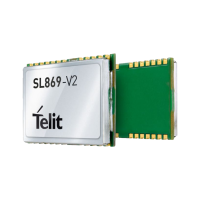• Partial or total path blockage (such as foliage or buildings)
• Multipath interference (caused by signal reflection)
• GNSS antenna characteristics
• Signal path after the GNSS antenna
The GNSS signal is relatively immune to attenuation from rainfall. However, it is heavily
influenced by attenuation due to foliage (such as tree canopies, etc.) as well as outright
blockage caused by buildings, terrain or other objects near the line of sight to each
specific GNSS satellite. This variable attenuation is highly dependent upon satellite
location. If enough satellites are blocked, say at a lower elevation, or all in one general
direction, the geometry of the remaining satellites will result is a lower accuracy of
position. The receiver reports this geometry effect in the form of PDOP, HDOP and VDOP
numbers.
For example, in a vehicular application, the GNSS antenna may be placed on the
dashboard or rear package tray of an automobile. The metal roof of the vehicle will cause
significant blockage, plus any thermal coating applied to the vehicle glass can attenuate
the GNSS signal by as much as 15 dB. Again, both of these factors will affect the
performance of the receiver.
Multipath interference is a phenomenon where the signal from a particular satellite is
reflected and is received by the GNSS antenna in addition to or in place of the line of sight
signal. The reflected signal has a path length that is longer than the line of sight path and
can either attenuate the original signal, or if received in place of the original signal, can
add error in determining a solution because the distance to the particular satellite is
actually shorter than measured. It is this phenomenon (as well as the partial sky
obscuration) that makes GNSS navigation in urban canyons (narrow roads surround by
high rise buildings) so challenging. In general, the reflection of a GNSS signal causes its
polarization to reverse. The implications of this are covered in the next section.
GNSS Antenna Polarization
The GPS, Glonass and BeiDou satellites all a broadcast signal that is Right Hand
Circularly Polarized (RHCP).
An RHCP antenna will have 3 dB gain compared to a linearly-polarized antenna
(assuming the same antenna gain specified in dBic and dBi respectively).
An RHCP antenna is better at rejecting multipath interference than a linearly polarized
antenna because the reflected signal changes polarization to LHCP. This signal would be
rejected by the RHCP antenna, typically by 20 dB or greater.

